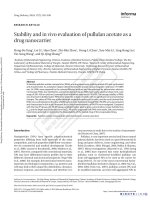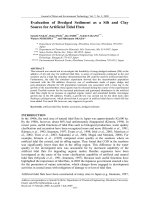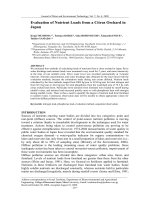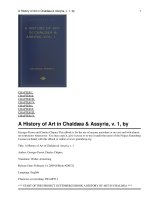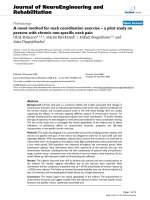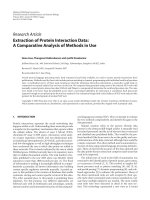Comparative evaluation of casting method over standing method of castration in bulls: A clinical study
Bạn đang xem bản rút gọn của tài liệu. Xem và tải ngay bản đầy đủ của tài liệu tại đây (227.72 KB, 4 trang )
Int.J.Curr.Microbiol.App.Sci (2019) 8(2): 693-696
International Journal of Current Microbiology and Applied Sciences
ISSN: 2319-7706 Volume 8 Number 02 (2019)
Journal homepage:
Original Research Article
/>
Comparative Evaluation of Casting Method over Standing Method of
Castration in Bulls: A Clinical Study
G.U. Yadav*, D.U. Lokhande, A.U. Bhikane and A.T. Yamgar
Department of Surgery and Radiology, Bombay Veterinary College, Parel, Mumbai -12, India
*Corresponding author
ABSTRACT
Keywords
Casting method,
Standing method,
Castration, Travis
Article Info
Accepted:
07 January 2019
Available Online:
10 February 2019
Twenty four bulls presented for castration to Department of Surgery and Radiology,
Bombay Veterinary College Parel, BSDPHA affiliated hospital and Department of TVCC,
COVAS, Udgir were studied for comparative evaluation of casting method and sanding
method of castration in bulls. All the animals were sedated with Xylazine @0.02mg/kg
BW, IM 30 minutes before castration. In 12 animals traditional casting method was
applied for castration and in other 12 animals standing method of castration was used. The
standing castration was performed by fixation of animals in Travis. The hind limbs were
tied to side rails of Travis separately and the scrotal bag was pulled back. The spermatic
cords were located and castration was performed. Standing method of castration is safe,
less time consuming with no accidental crushing of penis, and can be performed without
complications like radial nerve paralysis, bone and muscle injuries.
Introduction
Materials and Methods
Bloodless castration technique by using
burdizzo castrator is commonly practiced
under field conditions. Another satisfactory
method of castration is complete ablation of
scrotal sac under tranquilization and local
anaesthesia (Tyagi and Singh, 1996).
Irrespective of open or close technique,
casting of animal on ground is mandatory in
both the methods of castration. Present report
deals with comparative study of clinical cases
of castration performed in standing and
casting position in bulls.
Twenty four clinical cases of bulls of various
breeds presented for castration to Department
of Surgery and Radiology, Bombay
Veterinary College Parel, BSDPHA affiliated
hospital and Teaching Veterinary Clinical
Complex, Udgir formed the clinical material
for the present study. The percentage of cases
in relation to species, breed, and age were
studied. The duration required for regression
of hump, changes in skin coat, time required
for regression of testicle and changes in
length and breadth of testicle were studied.
693
Int.J.Curr.Microbiol.App.Sci (2019) 8(2): 693-696
All the animals in both groups were given
sedation with Xylazine @0.02mg/kg BW, IM
half hour before surgical intervention of
castration and after development of sedation
the castrations were performed.
for castration were bovines. Out of total 24
animals presented 50% (12) animals were
nondescript, 33% (8) animals were Red
Khandari and 16.66 %( 4) animals were
Deoni. All the animals presented for
castration were of 2 to 5 years age group and
no animals above 5 year age were presented
for castration. However O’Conner (1980)
suggested that castration in cattle can be
performed at the age of 6 weeks to 6 months.
The routine method of castration by casting
the animal on ground was performed in 12
animals. After casting of animal the German
made asculep castrator was attempted in 12
animals (Fig. 1).
Xylazine sedation was found useful for
castration in both methods. Oehme (1998)
advised standing method of castration in
horses under chloral hydrate sedation and
local anaesthesia. Routine casting method
was used in 12 cases and standing castration
method was applied in other 12 animals.
O’Connor (1980) reported the standing
method of castration by holding the animal
against the wall or partition and applying nose
ring. He also suggested that the horns of
animals should be tied and kicking trap must
be applied over the hocks to control the
animals by complete fixation. Whereas, Tyagi
and Singh (1996) suggested that casting
method is most suitable for castration in
bovines.
Other 12 animals were restrained in Travis by
tying the hind limbs separately to side rails of
travis and the head of animal was restrained
front side poll or bar of Travis. After proper
restraining in standing position the scrotal bag
of animal was pulled backward to the
maximum possible extant (Fig. 2) and
spermatic cords were located by taking all the
aseptic precautions and asculep was applied
on spermatic cord to crush spermatic cord for
2 minutes (Fig. 3), similar procedure was
applied for crushing of spermatic cord to the
other side. The animals in this group were
castrated by application of German made
asculep in the standing position. The
castration sites were dressed with Tincture
Iodine for three days. Streptopenicillin @ 10
mg/kg body weight was given for 3 days and
Meloxicam was given @0.3mg/kg body
weight for 3days. Clinical parameters of all
the animals were recorded in terms of heart
rate, respiration rate and rectal temperature
before and after castration. Healing of
surgical wounds, post operative libido, sex
behaviour etc were recorded post operatively.
Comparative aspects and effectiveness of the
above methods was also studied.
The physiological parameters like heart rate
(49.45 + 1.32/min in group I and 49.09 +1.31
min in group II), respiration rate (23.45 + 0.62
in group I and 24.72 + 0.73 min in group II)
and rectal temperature (101.09 + 0.21 0f in
group I and 100.91+ 0.15 0f in group II) were
normal in both the methods before and after
castration during 50 days of monitoring
period.
Strepto-penicilln given post operatively had
provided antibiotic coverage and meloxicam
provided antinflammatory effect to reduce the
swelling at the site. Daily dressing with
Tincture Iodine helped to prevent the bacterial
contamination at the site. Post operative
healing of scrotal wounds was normal in all
Results and Discussion
Castration in bovines is performed to render
the male animals docile and also to improve
the quality of flesh (Amresh Kumar, 1996). In
the present study all the 24 animals presented
694
Int.J.Curr.Microbiol.App.Sci (2019) 8(2): 693-696
the cases in 8-10 days and no any
complication was observed in both the
groups.
52.27 +1.06 in group I and 53.27 + 1.00 days
in group II after castration. The average
length of testicles was 5 inches and breadth
was 4.37 inches before castration operation.
The testicles were regressed normally within
46.09 + 0.86 days after castration in group I
and 45.81+ 0.90 days in group II.
Venugopalan (1994) reported that 30 days are
required for complete regression of testicles
after close method of castration. The libido
and sex behaviour were found to be reduced
within 90.54 +1.30 days in group I and in
90.00+ 1.07 days in group II animals. The
comparative aspects of standing castration
method versus casting method were as
follows.
The development of hump presented for
castration was more in 41.66% (10) animals
and moderate in 58.33% (14) animals, but
hump development was observed in all the
animals before castration. The moderate
hump regression was observed in 59.72+1.80
days of castration in group I and 61.81+ 1.31
in group II but complete regression was not
observed in any of the case after castration.
Rough skin coat was observed in all the
animals presented for castration and the
changes in skin coat i.e. moderate smoothness
of skin coat was observed in the animals upto
Table.1
Sr. No.
1
2
3
4
5
6
7
8
9
10
11
Standing castration Method
Easy to operate and easy to perform.
Requires less time and labours.
Can be performed in any season and
weather.
Chances of contamination at site of
castration i.e. castrator bite marks at the
base of testicle are less during surgery.
No need of casting only restraining in
standing position is required.
Post surgical complications are not
observed.
Position of spermatic cord is clear,
evident, easily palpable and not were
overlapping to each other.
Spermatic cords are clearly visible and
palpable so castration can be performed
easily.
The chances of accidental crushing of
penis is not possible
No complications like radial nerve
paralysis, muscle injury, injuries to
body parts, injuries to horns, tympany
and fracture.
Animal is comfortable during castration
in standing method.
Casting castration method
Casting procedure is risky and difficult to perform.
Requires more time and labours.
Only recommended in winter or cooler and dry season.
Due to casting the area where castrator bite marks are
present may come in contact with soil and more chances
of contamination during castration.
Needs casting.
Chances of soiling of wound and contamination were
present.
In casting method the spermatic cord remains horizontal
in position overlapping with each other due to
recumbent position of the animal so difficult.
For crushing of spermatic cord careful location and
palpation is required.
Accidentally the penis may get crushed.
Complications likely to occur. Casting may lead to
radial nerve paralysis, muscle injury, injuries to body
parts, injuries to horns, tympany and fracture.
Some discomfort to the animal due to casting may
occur.
695
Int.J.Curr.Microbiol.App.Sci (2019) 8(2): 693-696
Fig.1 Traditional casting method
Fig.2 Location of spermatic cords after
restraining the animal
Fig.3 Castration by standing method of
castration
and Wilkins, Sydney.
Tyagi R.P.S. and Singh J.P.(1996) Ruminant
Surgery,
CBS
Publishers
and
Distributors Delhi
Venugopalan A. (1994) Essentials of
Veterinary Surgery, Oxford and IBH
Publishers Co. Pvt. Ltd. Bombay.
References
Kumar.A. (1996)
Veterinary surgical
techniques. Vikas Publishing House.
Pvt. Ltd. New Delhi.
O’Conner J.J. (1980) Dollars Veterinary
Surgery 4th Edn. CBS, Publishers and
Distributers, Delhi.
Oehme, F.W.C. (1988) Textbook of large
Animal Surgery 2nd edition. Williams
How to cite this article:
Yadav, G.U., D.U. Lokhande, A.U. Bhikane and Yamgar, A.T. 2019. Comparative Evaluation
of Casting Method over Standing Method of Castration in Bulls: A Clinical Study.
Int.J.Curr.Microbiol.App.Sci. 8(02): 693-696. doi: />
696
